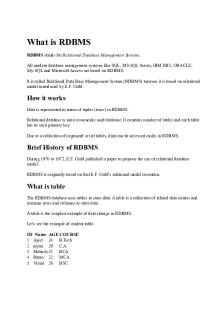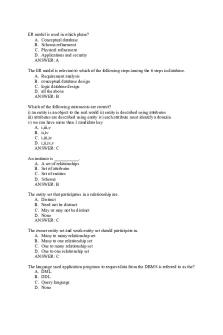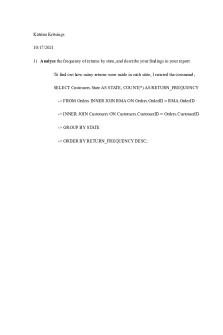LJU2 Databases 1 LJU2 Databases 1 LJU2 Databases 1 PDF

| Title | LJU2 Databases 1 LJU2 Databases 1 LJU2 Databases 1 |
|---|---|
| Author | Anda La Osa |
| Course | Databases 1 |
| Institution | University of the People |
| Pages | 2 |
| File Size | 68.3 KB |
| File Type | |
| Total Downloads | 50 |
| Total Views | 143 |
Summary
LJU2 Databases 1 LJU2 Databases 1 LJU2 Databases 1 LJU2 Databases 1 LJU2 Databases 1 LJU2 Databases 1 LJU2 Databases 1 LJU2 Databases 1 LJU2 Databases 1...
Description
In this learning journal, you should write a scenario that the user described requirements as in the Library Management System case study in Chapter 3.3 of Sharma et al. (2010, p. 77) during the interview. Requirements described in this interview could be transformed into the above E-R diagram. After writing the scenario, you should also describe the cardinalities in the above diagram. Introduction In the following paragraphs, I will simulate the questions and answers from a customer in order to gather information to develop the conceptual model for the database the customer required me to elaborate. The information provided by the customer should be enough to construct a graphical model that can help guide through the designing of the database. Questions and steps The following are the steps to developing the conceptual model that I would use as a guide to interviewing the customer in relation to the database they need: “Step 1 - Identify entities. Step 2 - Remove duplicate entities. Step 3 - List the attributes of each entity set. Step 4 - Choose a unique identifier. Step 5 - Define the relationship sets. Step 6 - Define business rules.” (Sharma et al., 2010) The questions in order to gather more information in each o the steps would be as follow: Step 1 - Identify entities: ● What’s the objective or the database? This one should help identify the different entities that are present in the database. ● What level of importance do you give to the database? The idea of this is to identify if the information the customer provides really means the correct information in order to solve their problem. ● Which are the main participants in this process you need to automate? Step 2 - Remove duplicate entities. ● Have you identified any repetitive components from the process? Step 3 - List the attributes of each entity set. ● From the previous participants identified in step # 1, do any of them have any special characteristics? ● Have you thought about any special characteristics that any of the participants can’t omit? Step 4 - Choose a unique identifier.
● From the special characteristics we talked about before, have you found out any that uniquely identifies each of the participants? It can be any numeration or word that just with it you can know about the participant. Step 5 - Define the relationship sets. ● How would you describe the interaction between the participants? ● Have you seen if any of them can own one or more interactions from the other one? Step 6 - Define business rules. ● Have you thought about any restriction you want to give to the employees with the rights to access the database? Like for example who can change, edit or delete data? ● Do you want to create a supervision process in order to avoid important data to be erased? ● Do you want the participants of the process to be informed about the data that is been collected? Conclusion The previous questions intended to gather information only the customer knows but that could also help us understand the business, the processes and the different participants in the different activities the customer pretends to automate with the database. After gathering all this information from the customer we can proceed to create a graphical model that the customer can approve or edit.
References Sharma, N., Perniu, L., Chong, R. F., Iyer, A., Nandan, C., Mitea, A. C., Nonvinkere, M. & Danubianu, M. (2010). Database fundamentals. IBM Canada....
Similar Free PDFs

Advanced Queries in Databases
- 129 Pages

Rdbms - relational databases
- 4 Pages

Forensic Databases revision
- 3 Pages

Chapter 4 Relational Databases
- 40 Pages

PDM Coded - MCQs for databases
- 7 Pages
Popular Institutions
- Tinajero National High School - Annex
- Politeknik Caltex Riau
- Yokohama City University
- SGT University
- University of Al-Qadisiyah
- Divine Word College of Vigan
- Techniek College Rotterdam
- Universidade de Santiago
- Universiti Teknologi MARA Cawangan Johor Kampus Pasir Gudang
- Poltekkes Kemenkes Yogyakarta
- Baguio City National High School
- Colegio san marcos
- preparatoria uno
- Centro de Bachillerato Tecnológico Industrial y de Servicios No. 107
- Dalian Maritime University
- Quang Trung Secondary School
- Colegio Tecnológico en Informática
- Corporación Regional de Educación Superior
- Grupo CEDVA
- Dar Al Uloom University
- Centro de Estudios Preuniversitarios de la Universidad Nacional de Ingeniería
- 上智大学
- Aakash International School, Nuna Majara
- San Felipe Neri Catholic School
- Kang Chiao International School - New Taipei City
- Misamis Occidental National High School
- Institución Educativa Escuela Normal Juan Ladrilleros
- Kolehiyo ng Pantukan
- Batanes State College
- Instituto Continental
- Sekolah Menengah Kejuruan Kesehatan Kaltara (Tarakan)
- Colegio de La Inmaculada Concepcion - Cebu










